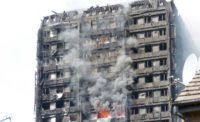

Accident specialists with the U.K. government have launched investigations into the early morning Jan. 16 helicopter crash into a crane attached to a 180-meter-tall residential building under construction in central London. Both the helicopter pilot and a man in the street were killed. Six days after the accident, the building contractor started removing the damaged crane and ordered a replacement to complete the Tower, One St George Wharf project later this year.
The twin-engine Agusta A-109E helicopter flying with a pilot and no passengers struck the jib of the Comedil CTL180 luffing tower crane while flying in darkness and fog about 8 a.m. in the Vauxhall area, on the south bank of the River Thames.
Part of the jib broke off and fell to the ground, while the damaged helicopter careened across a busy dual-lane highway and crashed in flames onto a quiet side street. Several low-rise apartment blocks next to the tower escaped damage. The crane operators had reported for work but had not yet climbed the tower at the time of the crash.
Rising from low-rise structures around it, the skyscraper is by far the tallest in that part of London. However, the shell-and-core contractor Brookfield Multiplex Ltd. had notified the Civil Aviation Authority of the crane's presence. "We had told pilots about [the crane], and it was lit during the night," says a CAA spokesman.
A day after the incident, the contractor brought in a 600-tonne capacity Terex TC2800-1 mobile crane with a 96-m tower, which is extendable by another 96 m. Snow storms initially delayed mobilization, but by Jan. 22, crews were able to remove the tower crane's A-frame. Previously, workers had secured or removed smaller, precarious pieces of the damaged crane.
Despite the impact, most of the tower crane and the building itself were found to be undamaged, following inspections by the contractor, its design firm, Australia-based Robert Bird Partnership, local authority and other engineers, according to a Brookfield Multiplex spokesman.
According to a Civil Aviation Authority official, single-engine helicopters in London must stick to a route along the Thames to avoid buildings. However, twin-engine machines, such the Agusta, are allowed to fly in a wider zone.



Post a comment to this article
Report Abusive Comment